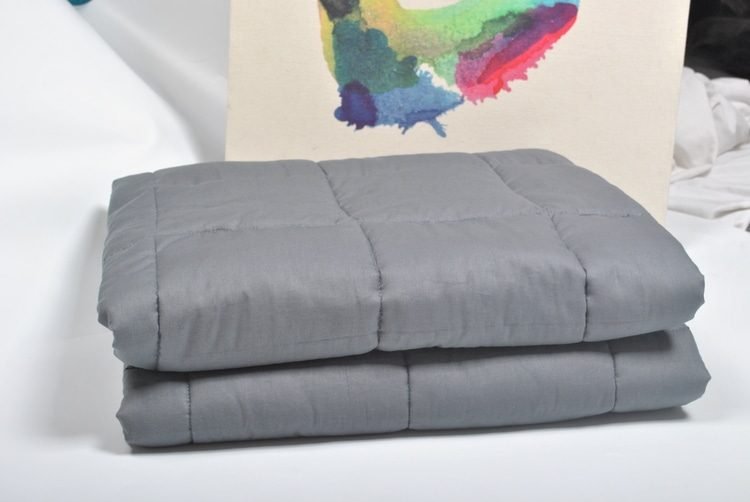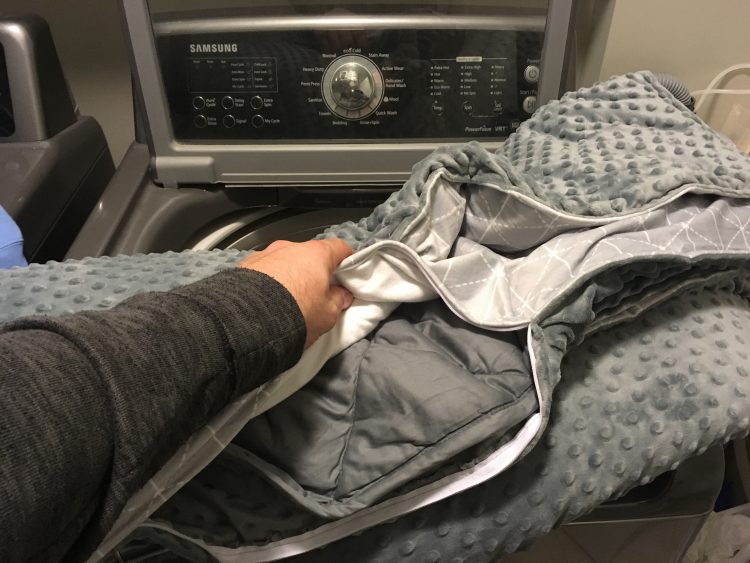Buying a weighted blanket is an investment and as such, you will want it to last as long as possible. This means taking the time to care for it properly.
The first thing to remember is that a weighted blanket is meant to cover the person, not the bed. So there is really no need to use your blanket as a bedspread. Fold it up and put it away or at the foot of your bed during the day. Just by doing that you will prolong the life of your blanket considerably because it won’t be subjected to the additional strain of daily activities.
Your pets won’t be shedding or leaving dirty footprints on it, necessitating extra washing. You won’t be sitting, eating, or working on it. Your kids won’t drip popsicles on it or drive Tonka trucks across it. Use a separate bedspread, quilt, or comforter and let your weighted blanket serve as a fashionable accessory when not in use.
Use a cover
The first step in ensuring a long life for your weighted blanket is protecting it from unnecessary wear.
Keeping it put away until you are ready to use it helps a lot. But just as a tablecloth protects your dining room table, a pillowcase protects your pillows, or a slipcover protects your sofa, a protective fabric barrier on your weighted blanket will protect it from damage, dirt, and wear.
Many retailers offer an optional cover, and some are actually sold as a two-part system, with the weighted blanket slipping inside a pillowcase-like cover.
The weighted blanket itself is typically made of 100% cotton fabric with stitched pockets of weighted beads, either polyester or glass. Most are washable but require special care. The outer covers that protect them are designed to be easily washed and dried and are usually a minky polyester or cotton print.
Why a cover is recommended
Fabric items become ruined when they are stained, torn, dirty beyond redemption, or worn out. By keeping a cover on the weighted inner blanket, which is the expensive part of the system, you protect it from getting stained or torn.
As for deteriorating, fabric becomes threadbare from handling or decays due to age. You can’t do anything about age, and let’s be honest, if your weighted blanket deteriorates from age, that’s a good thing. It means it lasted long enough to get old.
Friction is the enemy you want to avoid. Washing is hard on fabric because getting it clean requires rubbing it back and forth against itself or something else.
Machine drying weakens fabric by taking off tiny bits of material, which you recognize as lint in the filter, and it becomes easier to tear as less and less material remains. This is true of any tumble drying, even without heat, but heated air is much harder on the fabric.
How a cover can help
By using a cover, you can wash the actual weighted pad less often, and you preserve the most precious part of the system. The cover is much less expensive to replace and less bulky to wash.

Companies that sell them as a two-part system usually have ties to hold the two layers together to avoid movement and bunching up. This is probably the simplest approach, if not the cheapest. If the company you buy your weighted blanket from doesn’t offer a coordinating cover, many stores sell them, often called duvet covers for standard down or polyester filled comforters.
Another fun idea is to make your own outer cover. If you use two flat sheets, much of the hemming and finish work is done already, and it’s just a matter of sewing three sides together (you may need to take large seams to fit the blanket exactly) and adding ribbons to the top as tie closures.
Using two different prints makes the cover reversible and you can switch from minky/fleecy/flannel fabrics in the winter to light, bright cottons in the summer.
Choosing how to wash your blanket
Since the whole idea of a cover is to wash it and not the inner weighted blanket, it will probably be machine washable and safe to tumble dry. Remove the cover and toss it in the laundry with your sheets and pillowcases.
Tumble dry or put it out on the line if you prefer. Of course, make sure to read the instructions that come with your specific brand of cover. For instance, with some fabrics, you won’t need fabric softener and in fact, should avoid it.
The inside weighted pad will have its own special instructions, and it is crucially important to follow those instructions if you want your blanket to last.
Some manufacturers recommend dry cleaning, yet some actually forbid it. Interestingly, because dry cleaning is recommended for more expensive clothing fabrics such as silk and wool, we tend to think that it is the most gentle way to clean cloth. Actually, the chemicals are harsh and damaging over time, so less dry cleaning is always better, which is another reason to let the cover take the brunt of wear, tear, and laundering.
Inner blanket
The most common recommendation for cleaning the inner blanket is to machine wash on a gentle cycle or hand wash and air dry. But what is the best way to do that?
If you have a good washer with a gentle or hand wash cycle that you trust, go ahead and machine wash the inner blanket, provided that is one of the choices listed by the manufacturer.
Use the spin cycle to get out as much moisture as you can, because you will probably want to air or line dry and the less-wet it is to start, the shorter the drying time.
Another option, especially if you have a small or top-loading washer and you have a relatively large blanket, is to take it to the laundromat and use a machine provided for oversized items.
How to hand wash
Another option, a good option, is hand washing. Yes, it sounds daunting, but it is very doable if you know how. Follow these simple steps.
- The main thing you need is something large enough to wash your blanket in. A bathtub will work, or a deep sink, a large plastic storage bin, even a kiddie pool if the weather is warm enough to wash outside.
- Add a small amount of detergent. You can use a special hand washing laundry detergent like Woolite or Mrs. Meyers, but you don’t have to. A bit of shampoo or dishwashing liquid will work well. You may not want to use standard laundry detergent designed for a machine. It can leave a slippery residue on your skin.
- Add lukewarm or cold water, but only enough to cover the blanket.
- Swish – You can do this in a wide variety of ways. You can twirl and swirl the fabric through the water with your arm or a broom handle. You can use a brand new toilet plunger to gently push the fabric up and down. If you’re using a kiddie pool, you can even walk through the water, kicking and swirling the blanket as you go.
- Soak for up to 30 minutes
- Drain the water
- Press excess water out of the blanket
- Refill with fresh water
- Repeat the soak-drain-press-refill process until the blanket is rinsed.
Drying
Whether you hand wash the weighted portion of your blanket or machine wash on gentle, most manufacturers don’t recommend tumble drying.

You can compromise and machine dry it on a no-heat air fluff setting but check the instructions or label before doing this. Some people swear by this method as the best way to “air” dry but still get the rotation that leaves the fabric fluffy and soft. The most conservative approach is to air dry. How do you do that?
Unless the manufacturer’s instructions say otherwise, put your blanket in a washing machine spin cycle, even if you hand washed it, to spin out excess moisture first. If you have a clothesline – great! Drape it over the line. But there are other ways to hang a blanket up to dry.
- Push your shower curtain to one side and use the shower rod.
- Cover your bed with a shower curtain or cheap vinyl tablecloth and put the blanket on the bed as you would if you were making your bed.
- Use the tablecloth method above but drape your blanket over a sofa, dining room table, or even suspend it over 4 kitchen chairs like a kid’s fort.
- Hang the blanket over an open door (make sure to dust/clean the top of the door first because they can get really dusty).
Fastest way to air-dry
It will dry fastest on a clothesline, door, or shower rod because more surface area is exposed to the air at one time. But even drying only one side at a time, such as on a bed or table, will work.
Just make sure to flip it periodically no matter where it is hanging so it won’t dry with marks from the clothesline or chair it’s on. Any kind of breeze will hurry the process, so if you have electric fans, turn them on so as to blow air across the blanket.
Final Word
Whether you buy a blanket that is safe to wash and tumble dry or one that is listed as “spot clean only” you can extend the life of your blanket by keeping it safely out of the way when not in use, covering it with an easy-wash cover and cleaning carefully when needed.
Just remember – check the care instructions before you buy to make sure that the blanket you choose works well with your lifestyle. Then once you get it home, take the time to keep it clean and cared for so you can reap the therapeutic benefits for as long as possible.

